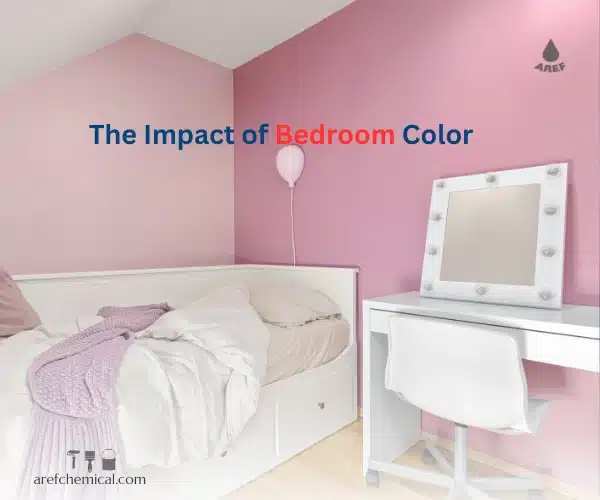The color of a bedroom is undoubtedly an important decision, as color is one of the most influential elements in interior design. It means that something can strongly influence how we feel, act, and our general well-being. The bedroom, as a place of rest and energy renewal, requires more attention to color selection than any other space in the home. Choosing the right color can improve sleep, reduce stress, and increase a sense of calm. Today, we’ll provide a comprehensive explanation of bedroom color.
1. The Psychology of Bedroom Color
The psychology of color plays a significant role in creating a calming and restful atmosphere in the bedroom. Cool tones like blue and green are known for their soothing properties, helping to reduce stress and improve sleep quality. On the other hand, warm colors such as red and orange may be stimulating and energizing, making them less suitable for bedrooms. Neutral shades like white, gray, and beige convey cleanliness and simplicity, and when used correctly, can create a balanced and pleasant space. The ideal bedroom color should reflect an individual’s personality and needs, promoting comfort and relaxation.
Each color has its own energy and psychological impact. Below are some commonly used bedroom colors and their effects:
Blue: Known as a calming color, blue slows the heart rate and evokes feelings of peace and security. Light blues and blue-grays are excellent choices for bedrooms.
Green: A symbol of nature and freshness, green can help reduce anxiety and promote emotional balance. The combination of soft greens with natural wood creates a warm, inviting, and calming environment.
Gray: While neutral, gray can provide a modern, clean, and serene feel when combined with warm or pastel tones. Lighter shades are preferable to avoid a dull, cold look.
Soft Purple (Lavender): Associated with spirituality and mental calm, light purple tones can add a romantic and peaceful vibe to the bedroom.
Pastel Pink: A sweet choice that promotes tenderness and affection, especially fitting for teens’ or couples’ bedrooms.
Beige and Cream: Warm, neutral shades like beige and cream offer a sense of comfort and are great for those who prefer softer color schemes.
2. Colors to Use with Caution
Certain colors should be used sparingly in the bedroom, particularly very warm and vibrant tones like red, orange, and bright yellow. These hues are highly stimulating and can increase irritability and decrease relaxation—undesirable traits for a sleep environment. Likewise, very dark colors such as black or deep purple can feel heavy or even depressing. However, if these colors are balanced with softer tones, they can add personality and charm to the room. Still, it’s crucial to use them thoughtfully to preserve a calm atmosphere.
Some visually appealing colors may not be suitable for bedrooms:
Red: Energetic and stimulating, red can raise the heart rate and potentially disrupt sleep if overused.
Bright Yellow or Bold Orange: Although cheerful, these tones can be overly stimulating for a bedroom, better reserved for decorative accents.
Black or Very Dark Shades: While modern and chic, these can make a room feel oppressive or somber. Strategic use, such as on an accent wall, can be more effective.
3. Practical Tips for Choosing Bedroom Colors
When selecting a bedroom color, start by considering your personality and emotional needs. Opt for colors that evoke calm and comfort for you. Cool, soft hues like blue, green, and gray are ideal for enhancing sleep quality. In contrast, overly bright or intense colors might boost energy and disrupt relaxation. Combining neutral tones with gentle accent colors creates harmony and balance. Choose shades that reflect natural light well, keeping the room bright and welcoming. Finally, coordinate wall colors with furniture and accessories to ensure visual cohesion.
Key tips include:
Consider Natural Light: Colors look different under various lighting. A color that feels gloomy in a dim room might appear inviting in a sunlit space.
Match with Decor Style: Warmer tones often suit traditional decor, while modern styles lean toward cool or neutral palettes.
Reflect Your Personality: Introverts may prefer calming, cool colors, while extroverts might enjoy more vibrant shades.
Balance Bold Colors: Use strong hues in moderation or as accents to maintain serenity.
Use Multiple Tones: Wall colors can be soft, while accessories add contrast and vibrancy.
How the Wrong Color Choice Affects Sleep and Mood
Choosing the wrong color for your bedroom can significantly affect sleep quality and mood. Very bright, bold, or warm colors like red and orange may increase nervous stimulation, restlessness, and make it harder to fall asleep. These shades can elevate heart rate and energy levels, undermining the calming purpose of the bedroom. Conversely, overly dark or cool tones might enhance feelings of loneliness, sadness, or fatigue. Therefore, choosing a suitable bedroom color is crucial for both better sleep and a more positive atmosphere.
The Importance of Color in Bedroom Design
The bedroom is one of the most vital parts of the home, directly influencing emotional well-being, rest, and physical health. One of the key design elements is the color palette used for walls, furniture, and accessories. Colors not only provide visual appeal but also impact mood and emotional state.
Psychological Effects of Bedroom Colors
Colors can evoke feelings of calm, happiness, energy, or even stress. For instance, soft and neutral hues like light blue, green, and pink create a peaceful atmosphere conducive to restful sleep. In contrast, dark colors such as black or deep brown may diminish feelings of peace and cause sadness or discomfort.
Recommended Bedroom Colors
Light Blue: One of the best bedroom colors for its calming and stress-reducing effects.
Soft Green: Its gentle, calming hue evokes feelings of tranquility and renewal, much like a lush, peaceful forest or a fresh spring meadow.
Light Pink: Enhances gentleness and calm, especially suitable for girls’ rooms.
Gray and Cream: Neutral tones that combine well with brighter accents to create a cozy, soothing space.
Tips for Choosing Bedroom Colors
Prioritize Personal Preference: The most important factor is selecting a color you love and that brings you comfort.
Assess Lighting Conditions: Evaluate how your chosen colors look under both natural and artificial lighting.
Limit Contrasts: Harmonious tones help maintain a clean, unified atmosphere.
Use Complementary Tones: Walls can be painted in calming colors while accessories introduce variety and interest. Its accent color too.
Conclusion
Beyond aesthetics, bedroom color plays a vital role in improving sleep quality, reducing stress, and uplifting mood. Creating a bedroom that feels both beautiful and inviting involves a thoughtful approach that combines color psychology with personal preferences and style. The right bedroom color supports mental health and restful sleep, turning your space into a comforting retreat. So, when designing your bedroom, give thoughtful attention to your color palette and enjoy the positive effects it brings.







7 Responses
Great 👍🏼
https://www.arefchemical.ir/
Thanks 😊
The color of your bedroom can significantly influence both your sleep quality and your overall mood. Colors have psychological and physiological effects that can either promote relaxation or induce alertness, depending on their hue, brightness, and saturation.
Soft Blues associated with calmness and tranquility, soft blue shades can lower heart rate and blood pressure, making it easier to relax and fall asleep.
Gentle Greens is considered a restful color, green has soothing properties that can reduce anxiety and promote a sense of peace.
Pale Lavenders and Lilacs Light purple hues can evoke relaxation without being overly stimulating, helping to create a peaceful environment.
Neutrals (Beige, Taupe, Light Gray), These shades are neutral and unobtrusive, promoting a calming atmosphere conducive to sleep.